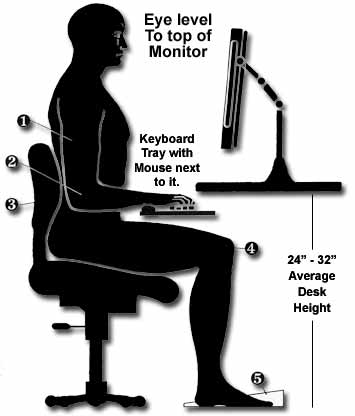
by Gemma Wills
Do you work at a computer all day? Do you often find yourself rubbing your sore eyes and fending off a headache by the time 5:30 rolls around?
If so, then it’s possible that you’ve experienced the symptoms of eye strain, also commonly known as Computer Vision Syndrome (CVS). Eye strain is characterized by blurred vision, dry eyes and headaches. It occurs when your blink-rate slows down as a result of your eyes focusing on a computer screen for long periods of time.
Although it can be irritating and uncomfortable, there are easy ways you can reduce the strain on your eyes. Read on for the definitive guide to protecting your eyes at work.
Are You Sitting Comfortably?
You can reduce strain on your eyes by positioning yourself at the right level and angle to your screen. Avoid sitting directly by a bright window or underneath an overhead light. By assessing the lightness level in your office or working environment, you can adjust the brightness of your monitor to a suitable level in order to avoid glare or squinting. If you read long documents on-screen, consider printing them out instead.
When sitting correctly at a desk, your back should be straight and your elbows bent at a 90 degree angle. Your screen should be around 20-26 inches around from your eyes. This position will optimize your comfort and minimize any straining of the eyes.
Give Your Eyes a Break
If you find you’ve been staring at your screen for hours on end without taking a break, stop! When working in front of a computer, you should always follow the 20-20-20 rule. Every 20 minutes, you should focus on an object 20 feet away from you for 20 seconds.
This exercise will both work and relax the eye muscles, as it allows them to focus on objects of a different size and at a different distance.
It may also help you to have a quick break and walk around the office to exercise the eyes in a similar way. Changing your immediate environment, stretching your muscles and breathing deeply will also help to make you feel less stressed and lessen the chance of a tension headache.
Just 5 minutes is enough to return you to your desk feeling refreshed and ready to resume work.
Eat and Drink Regularly
 Drinking water regularly throughout the day will help to keep you hydrated and help to prevent oncoming headaches. General lifestyle choices such as healthy eating will maintain your overall well-being and deliver essential nutrients to your eyes.
Drinking water regularly throughout the day will help to keep you hydrated and help to prevent oncoming headaches. General lifestyle choices such as healthy eating will maintain your overall well-being and deliver essential nutrients to your eyes.
While I’m sure everyone has heard that carrots are rich in vitamins and minerals that boost your eye health, there are many other foods which help to preserve good eyesight. Foods high in vitamin A such as dark green vegetables and oily fish like tuna and salmon are especially beneficial.
Work them into your diet a few times a week to ensure the health of your eyes for years to come. If you aren’t a fish fan, consider taking krill oil or omega-3 supplements to reap the same benefits. To read more about which foods to eat for good vision, click here.
Staying Comfortable in Contacts
If you wear contact lenses, you may find that your eyes become especially dry when working in front of a computer. This is due to the slowing of your blink rate and subsequent lack of moisture in your eyes.
You can counter this problem by ensuring you aren’t seated beneath an air conditioning vent or heating unit, and by taking your lenses out periodically to allow your eyes to produce more moisture.
Comfort drops are also a great solution for keeping eyes hydrated. You can easily buy these online. Make sure you pick a reputable site that provides testimonials.
It’s also a good idea to take an anti-bacterial hand gel with you to work, so that you can easily and safely remove your contact lenses if you need to.
Visit Your Optician
Eye strain is usually a mild and temporary condition, which is easily rectified by considering the above steps. However if you are regularly experiencing blurred vision, headaches and need to squint to see your computer screen, it may point to an underlying eye problem.
If you don’t currently wear contact lenses or glasses you may need to start, or if you do already then you may need to update your prescription. Most issues can be easily identified when you visit your Optician at your local eye center.
If you’d like to find out more information about protecting your eyes at work, visit webmd.com/eye-health.
By using these simple tips, you will be able to effectively protect your eyes at work. By reducing the symptoms of eye strain, you’re free to do what you do best.
(Gemma Wills is a writer for an online contact lens retailer called SameDayLenses.com. She regularly blogs about eye health and many other related topics.)





I have been working infront of a pc all day for almost ten years and sad to say i’ve never heard of the 20, 20 rule.
i do experience all of the above symptoms you explain my question is do you think after ten years my eyes are permanently damaged or by following the above mentioned exercises i will be able to fix my eye problems.